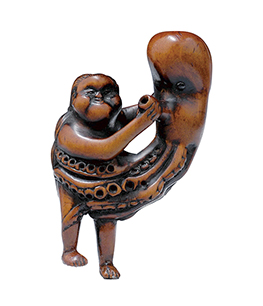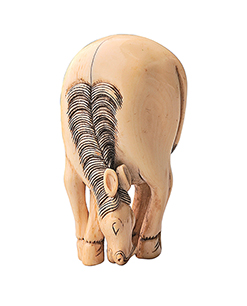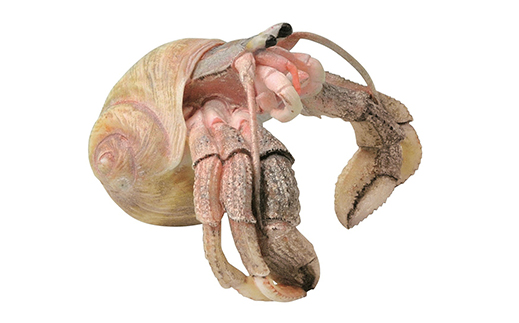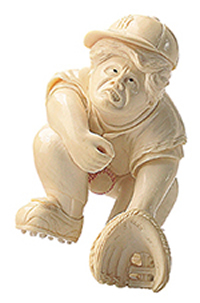 |
|
Here and There introduces art, artists, galleries and museums around Japan that non-Japanese readers and first-time visitors may find of particular interest. The writer claims no art expertise, just a subjective viewpoint acquired over many years' residence in Japan.
|
|
 |
|
|
 |
 |
Netsuke: An Impish Marriage of Form and Function
Alan Gleason |
 |
|
Shodo Asaoka, Go Players, 1965, ivory |
An exhibition of 300 sculptures sounds like it would barely squeeze into one of the big museums in Ueno, let alone a small municipal gallery in the Tokyo suburb of Mitaka. But the works in question readily fit several dozen to a showcase -- they are netsuke, and they are as entertaining as miniature art gets.
|
 |
|
|
|
Bishu Saito, Glare, 2016, ivory, tortoise shell. A contemporary netsuke coupled with an inro featuring a similar monkey motif, maker and year unknown.
|
Like ukiyo-e, netsuke seem to be one of those indigenous Japanese inventions that first captured the fancy of foreign aficionados and only then came to enjoy the status of fine art in their homeland. They were, after all, a very practical everyday item in their time: little toggles that hooked over a man's kimono sash to secure a cord attached to a sagemono -- any "hanging thing" but usually a purse or case for tobacco, pills, name seals, money and the like. Netsuke first appeared in the late 16th century along with the small nested boxes, known as inro, that comprised the most fashionable of these sagemono. They really caught on, however, with the rise of the merchant culture in Edo and other cities under the Tokugawa shogunate's two and a half centuries of rule. Wealthy urbanites, for whom a fancy inro was a status symbol, clamored for ever more elaborate toggles that might depict anything from one's profession to a mythical creature to a ribald anecdote. What had once been a side business for ivory and wood carvers blossomed into a full-time specialty, and competition was fierce.
As with any craft, form had to follow function, but the formal constraints of netsuke -- they had to fit on a sash, and hold a satchel of valuables in place -- only spurred their makers' ingenuity. The earlier pieces tend to be no more than three to five centimeters on a side, and the artists go to often hilarious lengths to conform to those dimensions -- a horse bent double while grazing, for example, his massive rump occupying most of the figure. Some netsuke were carved in elongated shapes, the better to hook securely over the sash. This configuration inspired some brilliant creations, too: a long strip of dried salmon, looking eminently edible, or a minuscule, perfectly rendered carpenter's plane. Whimsical juxtapositions of people, animals, fruit, and a variety of odd objects were popular: a hermit riding a carp, a monkey eating a peach, a woman diver battling an octopus (a critter that is for some reason a perennial favorite of netsuke artists).
 |
|
 |
|
Shugetsu, Woman Diver and Octopus, Edo period (undated), wood |
|
Unsigned (Kyoto), Horse, Edo period (undated), ivory |
Culled from the collection of the Kyoto Seishu Netsuke Art Museum, the works currently on exhibit until 20 March at the Mitaka City Gallery of Art provide a solid retrospective of netsuke art, from its Edo-period (1603-1867) heyday through a prewar revival to contemporary works that sometimes resemble traditional netsuke in dimensions only. I found the old Edo pieces the most beguiling. As with any newly emerging art form, they exude the glee with which the practitioners rose to a fresh formal challenge, vying to outdo one another and please their picky and monied clients with ever more clever designs. Humor and irreverence ran rampant. After all, these were commercial products, not high art -- the Edo equivalent, perhaps, of the decorative personalized straps on Tokyo teenagers' cell phones. Unfortunately, the provenance of most of these older netsuke is unknown, so the Mitaka show fails to enlighten us on when they were made, or in many cases by whom.
 |
|
Kodo Okuda, Hermit Crab, 1982, ivory |
With the opening of Japan in the mid-1800s and the advent of the modern Meiji state, Western garb replaced kimono and netsuke were rendered obsolete. Still, an early-20th century nostalgia boom in traditional arts and crafts gave birth to a renaissance of sorts, in which artists sought to reproduce the netsuke of times past. Part of the impetus came from the discovery of netsuke by Western visitors to Japan, sparking a surge in souvenir purchases and exports facilitated by their conveniently diminutive size. Though there were some experiments with materials and motifs, and a broader, brighter color palette, most of the examples on display from this period are faithful in style to those of a bygone era.
|
Miyabi Ochiai, Bell Peppers, 2007, ivory |
|
Yoka Mukaida, Duet, 2006, boxwood, abalone shell, ebony |
Modern netsuke took off much later, in the 1970s, egged on by enthusiasts overseas who began offering handsome commissions for new work. This renewed Western infatuation with netsuke encouraged a younger generation of carvers -- some but by no means all heirs to netsuke-artisan lineages dating back to Edo -- to begin producing radically innovative designs that would appeal to this new, well-heeled clientele. Non-Japanese netsuke artists also made an appearance. While these contemporary works are technically impressive, many seem to suffer from an excess of ambition -- as if the creators take the genre too seriously and are too bent on producing fine art to get as zany as their forebears. This begets all manner of byzantine neo-classical sculptures, smooth semi-abstract shapes, and kitschily gaudy ornamentation -- but very few pieces as subtly subversive as the work of the Edo masters.
|
 |
|
|
|
Akira Kuroiwa, Bad Hop, 2001, mammoth tusk, stag antler |
There are some imaginative exceptions, of course. Among the contemporary standouts are Miyabi Ochiai's tiny 3D still life Bell Peppers and his puckish Supreme Bliss, a pair of very lifelike ants crawling over a pile of sugar cubes; the violin and double bass limply entwined like Dali watches in Yoka Mukaida's Duet; a shrimp and octopus locked in a mortal tug of war in Jin Kuwabara's Natural Enemies; the elderly couple relaxing inside a hollowed-out orange in Hosen Miyazawa's Quiet Life; and Akira Kuroiwa's Bad Hop, a baseball player grimacing at the ball's unfortunately placed impact. But that's just scratching the surface. Whatever your taste in netsuke styles, nearly every one of the miniature sculptures on parade here rewards close, contemplative scrutiny. Be prepared to spend the better part of an afternoon to give them all their due.
|
Miwa, Humorous Dance, middle Edo period (undated), wood, ivory |
|
Unsigned, Foreigner with Ball, Edo period (undated), ivory |
All works are the property of the Kyoto Seishu Netsuke Art Museum. Images are courtesy of Sagawa Printing Co., Ltd. |
 |
| Netsuke: Forms that Connect the Edo Period and the Present Time |
| 14 January - 20 March 2017 |
| Mitaka City Gallery of Art |
5th floor, Coral Bldg., 3-35-1 Shimo-Renjaku, Mitaka, Tokyo
Phone: 0422-79-0033
Hours: 10 a.m. to 8 p.m. (last entry at 7:30 p.m.)
Closed on Mondays (open on 20 March)
Access: Directly across from the south exit of Mitaka Station on the JR Chuo Line (20 minutes west of Shinjuku, Tokyo) |
|
|
|
| |
 |
Alan Gleason
Alan Gleason is a translator, editor and writer based in Tokyo, where he has lived for 30 years. In addition to writing about the Japanese art scene he has edited and translated works on Japanese theater (from kabuki to the avant-garde) and music (both traditional and contemporary). |
|
|
|
|
|
|
|
|
|
 |
|